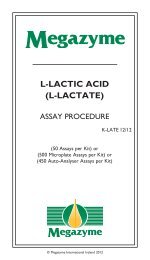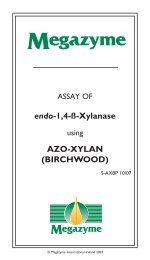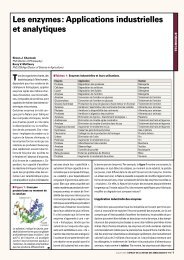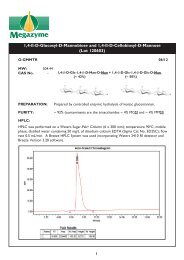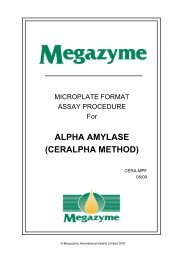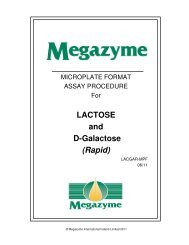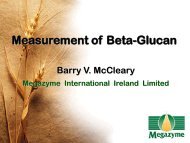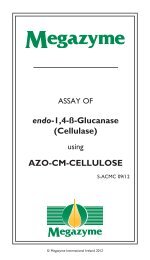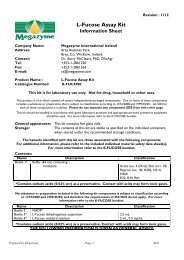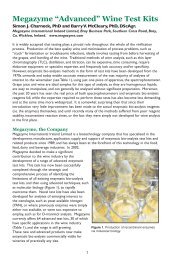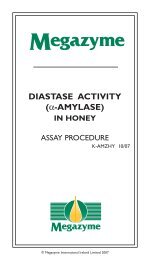ALPHA-AMYLASE - Megazyme
ALPHA-AMYLASE - Megazyme
ALPHA-AMYLASE - Megazyme
- No tags were found...
Create successful ePaper yourself
Turn your PDF publications into a flip-book with our unique Google optimized e-Paper software.
CONTROLS AND PRECAUTIONS:1. α-Amylase is an enzyme present at high levels in all body fluids.It is thus recommended that disposable gloves are used whenhandling and dispensing the substrate mixture.2. It is essential that the water used to dissolve the Ceralphasubstrate mixture is high purity. If freshly distilled water is notavailable, heat the water to boiling and cool it to less than 30°Cbefore using. Algal growth in water in wash bottles can producesufficient α-amylase to significantly reduce the long-term stabilityof the reagent dissolved in such water.3. The freeze-dried substrate is extremely stable at roomtemperature, however, when dissolved it should be stored at0-5°C during use and at -20°C between use. If the number ofassays performed at any one time is limited, it is recommendedthat the substrate be divided into 2-3 mL aliquots and stored inthe frozen state.4. On storage at 0-5°C, the blank absorbance values will increasefrom 0.03 to about 0.06 in 5 days, this does not affect theperformance of the substrate, but obviously these values must bedetermined at the same time as the assay is performed. Blankabsorbance values as high as 0.50 do not affect the reliability oraccuracy of the assay.A single Reaction Blank only is normally sufficient for each batchof samples being analysed. To obtain this blank value, 3.0 mLof stopping reagent should be added to 0.2 mL of substratesolution. Then add 0.2 mL of enzyme preparation.5. The spectrophotometer employed should be standardised witha p-nitrophenol standard in 1% Trizma Base (E mM= 18.1).p-Nitrophenol solution (10 µmoles per mL) can be obtained fromSigma Chemical Company (cat no.104-1). An aliquot of thissolution when diluted 200-fold in 1% Trizma base gives an absorbanceof 0.905 at 400 nm.6. The assay format should be standardised with the enclosed maltflour. The activity of this flour is shown on the enclosed vial. Awheat flour standard can be provided on request.7. The time of extraction of wheat flours should be controlledcarefully (5±1min). With longer extraction times, α-amylase bindsto the starch granules resulting in lower activity in the extract.With malt flour samples, the optimal extraction time is 15 min.5
USEFUL HINTS:1. If absorbance values for a particular assay are greater than 1.50,then the enzyme extract should be diluted appropriately withExtraction Buffer and re-assayed. Appropriate corrections to thecalculations should then be made.2. The number of assays which can be performed per kit canbe doubled by halving the volumes of all reagents used andemploying semi-micro spectrophotometer tubes.ASSAY PROCEDURE:Enzyme Extraction (Wheat and Barley Flours):1. Mill wheat, barley or other grain (approximately 2-10 g sample)to pass a 0.5 mm screen (e.g. with Tecator Cyclotec ® mill).2. Weigh accurately 0.5 g of flour into centrifuge tubes of 12 mLcapacity.3. To each tube add a 5.0 mL aliquot of Extraction Buffer solution(pH 5.2) and stir the contents vigorously.4. Allow the enzyme to extract over a 5±1 minute period at roomtemperature, with occasional mixing.5. Filter the solution through a Whatman GF/A glass fibre filterpaper, or centrifuge at 1,000 g for ten minutes. Assay activitywithin two hours.Enzyme Extraction (Malt Flour):1. Mill malt (20 g sample) to pass a 0.5 mm screen.2. Weigh accurately 0.5 g malt flour into a 100 mL volumetric flask.3. To the volumetric flask add a solution of 1% sodium chloride plus0.02% calcium chloride plus 0.02% sodium azide; adjust to volume.4. Allow the enzyme to extract for approximately 15 minutes atroom temperature, with occasional mixing.5. Filter an aliquot of the solution through a Whatman GF/A glassfibre filter paper, or centrifuge at 1,000 g for ten minutes.6. Dilute 0.5 mL of the filtrate with 9.5 mL of Extraction BufferSolution. Assay activity within two hours.6
Assay of α-Amylase:1. Dispense 0.2 mL aliquots of Ceralpha substrate solution into testtubes and pre-incubate the tubes and contents at 40°C for fiveminutes.2. Pre-incubate wheat, barley or malt extract at 40°C for five minutes.3. To each tube containing Ceralpha Substrate Solution (0.2 mL),add an aliquot (0.2 mL) of pre-equilibrated (and suitably diluted)wheat, barley or malt extract directly to the bottom of the tube.Incubate at 40°C for exactly ten minutes (from time of addition).4. At the end of the ten minute incubation add exactly 3.0 mL ofStopping Reagent and stir the tube contents vigorously.5. Read the absorbance (at 400 nm) of the solutions and the reactionblank against distilled water.CALCULATION OF ACTIVITY:Units/g Flour:∆E 400= x x x xIncubationTimeTotal Volume in CellAliquot Assayed1E m MExtraction VolumeSample WeightDilutionwhere:Δ E 400 = Absorbance (reaction) - Absorbance (blank)Incubation Time = 10 minsTotal Volume in Cell = 3.4 mL (or 1.7 mL)Aliquot Assayed = 0.2 mL (or 0.1 mL)E mMof p-nitrophenol in 1% Trizma base = 18.1Extraction volume = 5 mL per 0.5 gram (wheat and barley)or 100 mL per 0.5 gram (malt)Dilution = 20 fold (for malt extracts only).7
Thus for Wheat and Barley:Units/g flour:∆E 400= x x x103.40.2∆E 400= x0.939118.150.5For Malt:∆E 400103.40.2118.11000.5= x x x x20=∆E 400 x 375.7One Unit of activity is defined as the amount of enzyme, in thepresence of excess α-glucosidase and glucoamylase, requiredto release one micromole of p-nitrophenol from BPNPG7 inone minute under the defined assay conditions, and is termed aCeralpha Unit.CONVERSION OF ACTIVITY TO INTERNATIONALUNITS ON STARCH SUBSTRATE:The activity of pure wheat α-amylase on BPNPG7 substrate andsoluble starch (1% w/v) in extraction buffer solution (assayedusing the Nelson-Somogyi reducing sugar procedure) have beencompared and a conversion factor of 3.0 obtained; i.e. Units ofactivity on soluble starch (Nelson/Somogyi assay) equals 3.0 xUnits of activity on BPNPG7.A similar value (3.2) has been obtained for a temperaturestable Bacillus subtilis α-amylase preparation.COMPARISON OF CER<strong>ALPHA</strong> AND FARRANDMETHODS FOR WHEAT AND FUNGAL α-<strong>AMYLASE</strong>S:A slightly modified version of the Ceralpha method has beendeveloped for this purpose. This document can be accessed fromthe <strong>Megazyme</strong> website (www.megazyme.com) under “Ceralpha VsFarrand Methods”.8
ASSAY OF α-<strong>AMYLASE</strong> IN MICROBIALFERMENTATION BROTHS:The procedure described here can be directly adapted to the assayof α-amylase in bacterial and fungal fermentation broths. The assayshould be performed exactly as described for cereal flour extractswith the modification that the assay pH should be adjusted to suitthe particular α-amylase being measured. Fungal α-amylases areusually assayed at pH 5.0, while bacterial α-amylases are assayedat pH 6.0. Thus to adapt this kit for the assay of fungal α-amylase,the pH of the Extraction Buffer should be adjusted to 5.0 (with 1 Mhydrochloric acid) and the fermentation broth serially diluted in thisbuffer to obtain an activity value within the measurable range. Forbacterial α-amylases, the Extraction Buffer should be adjusted topH 6.0 (with 2 M sodium hydroxide).Absorbance, 400 nmFigure 1.Linearity of the Ceralpha α-amylase assay with enzymeconcentration and incubation time.D = x; C = 2x; B = 3x; A = 4x.9
Blocked p-nitrophenyl maltoheptaoside (BPNPG7)α-AmylaseBlocked maltosaccharidep-nitrophenyl maltosaccharideglucoamylaseα-glucosidaseTrizma baseReaction Stopped andyellow colour developedScheme 1. Theoretical basis of the Ceralpha α-amylase assayprocedure employing Cereal α-Amylase Assay Reagent.Immediately α-amylase cleaves a bond within the blockedp-nitrophenyl maltosaccharide substrate, the non-blocked reaction productcontaining the p-nitrophenyl substituent is instantly cleaved to glucose andfree p-nitrophenol by the excess quantities of glucoamylase andα-glucosidase which are integral parts of the substrate mixture, and freep-nitrophenol is released. The reaction is terminated and the phenolatecolour is developed on addition of Trizma base (pH 9.0).10
<strong>Megazyme</strong> International Ireland,Bray Business Park, Bray,Co. Wicklow,IRELAND.Telephone: (353.1) 286 1220Facsimile: (353.1) 286 1264Internet: www.megazyme.comE-Mail: info@megazyme.comWITHOUT GUARANTEEThe information contained in this booklet is, to the best of our knowledge, true and accurate, butsince the conditions of use are beyond our control, no warranty is given or is implied in respect ofany recommendation or suggestions which may be made or that any use will not infringe any patents.11




